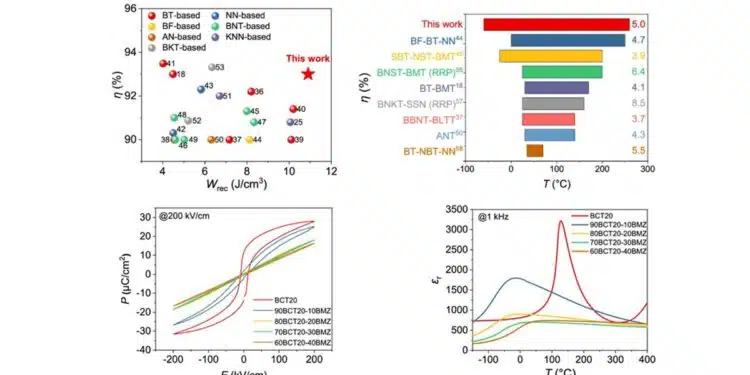The article from Nature Communications by Chinese Researchers delves into the innovative development of high-entropy engineered BaTiO3-based ceramic capacitors, which have shown remarkable improvements in high-temperature energy storage performance.
Key points
These capacitors achieved a significant recoverable energy density of 10.9 J/cm³ and an impressive energy efficiency of 93% at an applied electric field of 720 kV/cm. Notably, they maintain excellent energy storage capabilities across a wide temperature range of -50 to 260°C, with minimal variation and high cycling reliability up to 10^6 cycles at 450 kV/cm and 200°C. This study underscores the effectiveness of high-entropy engineering in creating high-performance dielectric capacitors for modern electrical applications.
The high-entropy design, characterized by a high configuration entropy and tolerance factor, contributed to the superior energy storage properties, including a high breakdown strength and low leakage current.
High-entropy 70BCT20-30BMZ ceramics exhibit ultrahigh cycling reliability and stable energy storage performance over a wide temperature range. This stability is attributed to the presence of high-dynamic nano polar regions (PNRs) that prevent the formation of large domains, leading to minimal dielectric loss and conductivity. The ceramics also demonstrate excellent high-temperature insulation properties, with a high activation energy for conductivity and a wide temperature range where efficiency exceeds 90%.
High-entropy ceramics, specifically (100-100x)BCT20-100xBMZ (x = 0 ~ 0.4), were synthesized and characterized, with 70BCT20-30BMZ exhibiting excellent energy storage performance at both room temperature and high temperatures. This is attributed to the high configuration entropy, which induces large lattice distortion and random local fields, resulting in robust thermal and electrical stability. The dynamic polarization nanoregions (PNRs) in the ceramics, revealed by in-situ characterizations, contribute to their superior high-temperature energy storage performance and cycling reliability.
Abstract
Ceramic capacitors with ultrahigh power density are crucial in modern electrical applications, especially under high-temperature conditions. However, the relatively low energy density limits their application scope and hinders device miniaturization and integration. In this work, we present a high-entropy BaTiO3-based relaxor ceramic with outstanding energy storage properties, achieving a substantial recoverable energy density of 10.9 J/cm3 and a superior energy efficiency of 93% at applied electric field of 720 kV/cm. Of particular importance is that the studied high-entropy composition exhibits excellent energy storage performance across a wide temperature range of −50 to 260 °C, with variation below 9%, additionally, it demonstrates great cycling reliability at 450 kV/cm and 200 °C up to 106cycles. Electrical and in-situ structural characterizations revealed that the high-entropy engineered local structures are highly stable under varying temperature and electric fields, leading to superior energy storage performance. This study provides a good paradigm of the efficacy of the high-entropy engineering for developing high-performance dielectric capacitors.
Summary
(100-100x)BCT20-100xBMZ (x = 0 ~ 0.4) ceramics were synthesized and characterized, with configuration entropy increasing with x. Thoroughly considering Wrecand η, high-entropy composition 70BCT20-30BMZ was selected for in-depth studies. This composition exhibits both a high Wrec of 10.9 J/cm3 and a high η of 93%, along with excellent cycling reliability at room temperature. Of particular importance is that 70BCT20-30BMZ ceramics also showed excellent high-temperature stability with ΔWrec < 9% and Δη < 5% over a broad temperature range of −50 °C to 260 °C, meanwhile exhibiting superior cycling reliability with minimal property degradation after cycling at 450 kV/cm and 200 °C. Electrical and in-situ characterizations revealed the PNRs in the ceramics are highly dynamic under varying temperatures and electric fields, attributed to the high-entropy engineering. This dynamic PNRs underscores the excellent high-temperature energy storage performance and high cycling reliability. This research highlights the significant potential of 70BCT20-30BMZ ceramics for high-temperature capacitors, and demonstrates that high-entropy design is an effective strategy in developing high-performance dielectric materials.
Read the full paper here: Kong, X., Yang, L., Meng, F. et al. High-entropy engineered BaTiO3-based ceramic capacitors with greatly enhanced high-temperature energy storage performance. Nat Commun 16, 885 (2025). https://doi.org/10.1038/s41467-025-56195-0































